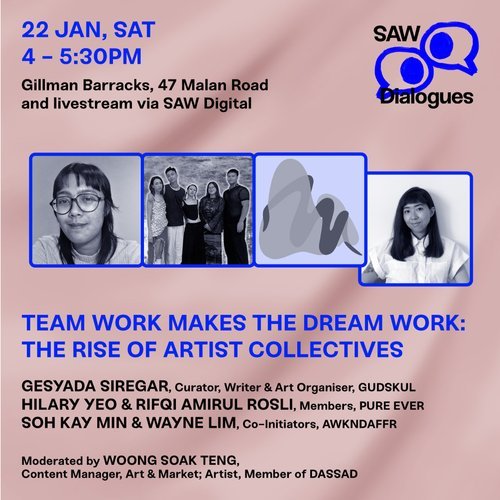SAW Dialogues 2022 | Collaborative Exhibition Making
Alfonse Chiu, Chum Chanveasna, Kourn Lyna, Ong Kian Peng, Lu Xiaohui
By Bryson Ng
Screenshot of talk. From left to right: Kourn Lyna, Public Program Coordinator, Sa Sa Art Projects, Phnom Penh, Cambodia, Chum Chanveasna, Manager, Sa Sa Art Projects, Phnom Penh, Cambodia, Lu Xiaohui, Programmer (Visual Arts), Esplanade – Theatres on the Bay, Alfonse Chiu, Co-Founder & Curator, Moving Picture Experiment Group (MPEG), Ong Kian Peng, Curator & Organiser, Supernormal.space.
Key points:
Collaborative models of production allow artists to experiment with a range of approaches and mediums.
Collaborations engender learning for all parties involved.
Open communication is key for effective collaboration.
‘Collaborative Exhibition Making’, which took place on 21 January 2022 from 8pm to 9pm as a part of SAW Dialogues 2022, explored the motivations and impacts of collaborative models of production for exhibition-making that were adopted by art collectives and independent art spaces throughout Singapore and Southeast Asia in recent years. These collaborative models often culminated in the creation of multimedia exhibitions, curatorial work, and artistic workshops. The panel featured Alfonse Chiu, Curator and Co-Founder, Moving Picture Experiment Group (MPEG), Chum Chanveasna, Manager, Sa Sa Art Projects, Kourn Lyna, Public Programme Coordinator, Sa Sa Art Projects, and Ong Kian Peng, Curator and Organiser, Supernormal.space. This session was moderated by Lu Xiaohui, Programmer, Esplanade – Theatres on the Bay.
Here are the takeaways:
Collaborative models of production allow artists to experiment with a range of approaches and mediums. Chum and Kourn talked about how collaborations with Sa Sa Art Projects span various levels, from art exhibitions that involve international, regional and local artists, to artist residencies and community-based art education workshops. These are united by the collaborators’ vision to build creative spaces that engage with the local Cambodian community. For instance, Open Studio: ColLABoration (2019-2020) was an educational exchange programme that Sa Sa Art Projects conducted in collaboration with Chiang Mai University, which focused on enabling young artists to develop their artistic ideas through talks, experimentation and workshops. Alfonse elaborated on how MPEG approaches the subject of the moving image in contemporary visual cultures through a uniquely experimental and interdisciplinary methodology that integrates arts-based research with curatorial content. On that note, Kian Peng shared that Supernormal often collaborates with local and international artists to work on art exhibitions and workshops that aim to foster a deeper examination of the relationship between art and technology. An example is Workshoppables organised with artist Michael Lee, which features experimental workshop arrangements encompassing online, physical, and hybrid formats.
Collaborations engender learning for all parties involved. Kian Peng observed that mutual learning can take place not only for audiences of exhibitions and workshops, but also for organisers. This thus cultivates a sense of re-thinking about what it means to work together within an artistically collaborative setting. Echoing this sentiment, Alfonse explained that MPEG is informed by the artists’ own recognition of the positionalities that they and their artworks embody within the extended art-media ecology. Similarly, Kourn emphasised that a key focus of art exhibitions under Sa Sa Art Projects is to build sustained channels of knowledge-sharing between the artists, the local art communities, and the public audience in the long run. At the nexus of this focus is a continual transmission of art education and knowledge among all parties involved, so as to sustain the collaborative work.
Open communication is key for effective collaboration. Kian Peng emphasised that most of the collaborations in Supernormal.space often stem from organic discussions that are related to mutually shared interests in art. Such conversations allow potential collaborators to gauge the possibility of positive teamwork. Similarly, both Chum and Kourn from Sa Sa Art Projects shared that their collaborators are not randomly chosen artists. Rather, they are friends or recommendations from their social networks. The collaborators then work towards building a long-term channel of active communication together, to actualise their shared artistic visions. Likewise, Alfonse shared that MPEG has developed as a result of shared conversations about intersecting interests in the moving image, as well as a collective desire to continue this shared affinity under a working model of conviviality and responsibility.
In sum, the dialogue saw an in-depth conversation on the nature of collaborative exhibition-making, its wider impact on artistic and curatorial practices throughout Singapore and Southeast Asia, and the potential of these efforts to create new and exciting work in the near future.
Watch the full recording of ‘SAW Dialogues 2022 | Collaborative Exhibition Making’ here:
About the writer:
Bryson is a writer and researcher of the arts, media, and the moving image. Having recently graduated from Yale-NUS with a major in Philosophy, Politics, and Economics, Bryson currently works for the National Library Board of Singapore as a Research Fellow of the digital humanities. In his free time, Bryson is an avid enthusiast of genre films, punk rock, and interacting with cats and dogs.















